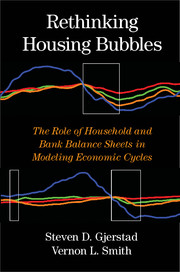 Rethinking Housing Bubbles
Rethinking Housing Bubbles Book contents
- Frontmatter
- Contents
- Acknowledgments
- 1 Economic Crises, Economic Policy, and Economic Analysis
- 2 Goods and Services Markets versus Asset Markets
- 3 Asset Performance
- 4 The Great Depression
- 5 The Postwar Recessions
- 6 What May Have Triggered or Sustained the Housing Bubble (1997–2006)?
- 7 The Bubble Bursts
- 8 Blindsided Experts
- 9 What Might Be Done?
- 10 Learning from Foreign Economic Crises
- 11 Summary: What Have We Learned?
- Index
- References
1 - Economic Crises, Economic Policy, and Economic Analysis
Published online by Cambridge University Press: 05 June 2014
- Frontmatter
- Contents
- Acknowledgments
- 1 Economic Crises, Economic Policy, and Economic Analysis
- 2 Goods and Services Markets versus Asset Markets
- 3 Asset Performance
- 4 The Great Depression
- 5 The Postwar Recessions
- 6 What May Have Triggered or Sustained the Housing Bubble (1997–2006)?
- 7 The Bubble Bursts
- 8 Blindsided Experts
- 9 What Might Be Done?
- 10 Learning from Foreign Economic Crises
- 11 Summary: What Have We Learned?
- Index
- References
Summary
The committee determined that a trough in business activity occurred in the U.S. economy in June 2009. The trough marks the end of the recession that began in December 2007 and the beginning of an expansion. The recession lasted 18 months, which makes it the longest of any recession since World War II.
– Business Cycle Dating Committee, National Bureau of Economic Research, September 20, 2010The crisis showed that the standard macroeconomic models used by central bankers and other policymakers…contain…no banks. They were omitted because macroeconomists thought of them as a simple “veil” between savers and borrowers.
– The Economist, January 19, 2013Macroeconomic Policy: Failed Expectations
In a speech on January 10, 2008, when the National Bureau of Economic Research (NBER) had yet to declare that a recession had begun in the previous month, Chairman of the Federal Reserve Ben Bernanke stated: “We stand ready to take substantive additional action as needed to support growth and to provide adequate insurance against downside risks.” Then, in response to a question following his speech, Bernanke replied that “The Federal Reserve is not currently forecasting a recession” but noted that it was, however, “forecasting slow growth.”
- Type
- Chapter
- Information
- Rethinking Housing BubblesThe Role of Household and Bank Balance Sheets in Modeling Economic Cycles, pp. 1 - 19Publisher: Cambridge University PressPrint publication year: 2014


